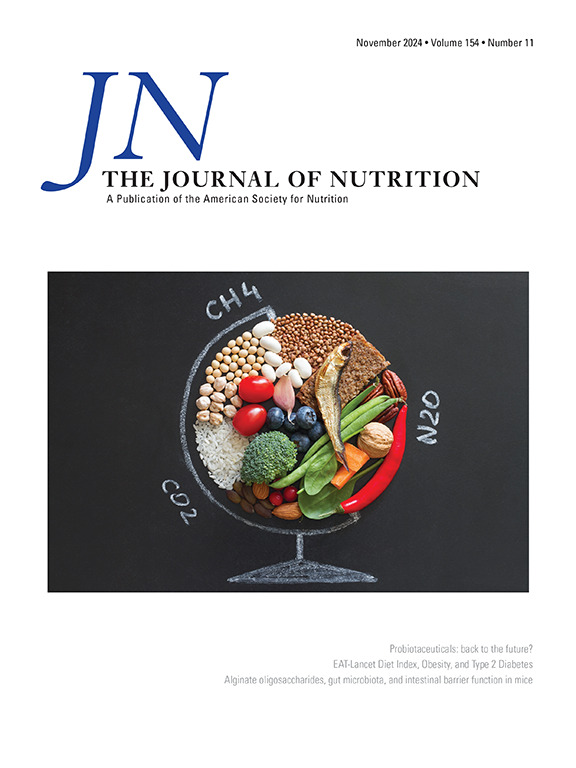Placental Metabolism Is Linked to Prenatal Vitamin Supplement Use in the First Month of Pregnancy in the MARBLES Cohort
IF 3.8
3区 医学
Q2 NUTRITION & DIETETICS
引用次数: 0
Abstract
Background
The first month of pregnancy is a key time in early developmental programming. Prenatal vitamin/mineral supplement use during the first month of pregnancy (PNVmo1) was associated with reduced risk of autism spectrum disorder (ASD) in the Markers of Autism Risk in Babies, Learning Early Signs (MARBLES) cohort.
Objectives
We aimed to evaluate the associations between PNVmo1, the placental and umbilical cord serum metabolomes, and the child’s later neurodevelopmental outcome in the MARBLES pregnancy cohort.
Methods
Placental (n = 78) and umbilical cord serum (n = 132) metabolomes were investigated using 1H nuclear magnetic resonance spectroscopy. PNVmo1 was determined by self-report. At 36 mo of age, child neurodevelopmental outcomes were classified by MARBLES clinicians into 3 groups: typically developing (TD), ASD, or nontypically developing (Non-TD) but not ASD, which was dominated by developmental delays and/or elevated autism symptoms but not meeting ASD criteria.
Results
After adjustment for covariates, permutational multivariate analysis of variance revealed that PNVmo1 was significantly (P < 0.05) associated with the placental and umbilical cord serum metabolomes. In the placenta, higher concentrations of amino acids were observed in the PNVmo1 group (false discovery rate <0.1). After adjustment for PNVmo1 and other covariates, permutational multivariate analysis of variance revealed a significant association (P < 0.05) between the placental metabolome and Non-TD outcome status. No associations were observed in the analyses of umbilical cord serum metabolism or with ASD outcome. We tested for but did not find evidence that the placental metabolome explained the relationship between PNVmo1 and Non-TD outcome in an exploratory mediation analysis.
Conclusions
These findings suggest that the placental metabolome could be sensitive to nutrient supplementation during the earliest stages of pregnancy.
在MARBLES队列中,胎盘代谢与妊娠第一个月产前维生素补充剂的使用有关。
背景:妊娠第一个月是早期发育规划的关键时期。在婴儿自闭症风险标记,学习早期迹象(MARBLES)队列中,怀孕第一个月产前维生素/矿物质补充剂的使用(PNVmo1)与自闭症谱系障碍(ASD)风险降低相关。目的:我们的目的是评估PNVmo1、胎盘和脐带血清代谢组与妊娠队列中儿童后期神经发育结局之间的关系。方法:采用1H核磁共振波谱法测定胎盘(78例)和脐带血清(132例)代谢组。PNVmo1采用自述法测定。在36个月大时,儿童神经发育结果被大理石临床医生分为三组:典型发育(TD), ASD,或非典型发育(Non-TD),但不是ASD,主要是发育迟缓和/或自闭症症状升高,但不符合ASD标准。结果:调整协变量后,排列多变量方差分析(peromova)显示PNVmo1显著(p)。结论:这些发现表明胎盘代谢组可能对妊娠早期营养补充敏感。
本文章由计算机程序翻译,如有差异,请以英文原文为准。
求助全文
约1分钟内获得全文
求助全文
来源期刊

Journal of Nutrition
医学-营养学
CiteScore
7.60
自引率
4.80%
发文量
260
审稿时长
39 days
期刊介绍:
The Journal of Nutrition (JN/J Nutr) publishes peer-reviewed original research papers covering all aspects of experimental nutrition in humans and other animal species; special articles such as reviews and biographies of prominent nutrition scientists; and issues, opinions, and commentaries on controversial issues in nutrition. Supplements are frequently published to provide extended discussion of topics of special interest.
 求助内容:
求助内容: 应助结果提醒方式:
应助结果提醒方式:


